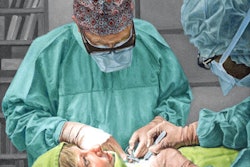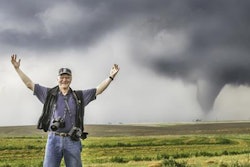
One way radiology can shift into art is as an extension of how it's used medically -- for example, by revealing the delicate internal structure of a flower. A Missouri radiologist is taking a different approach, using clinical images as building blocks to create something entirely new.
Brett Prywitch, MD, a radiologist at Dugan Radiology Associates in St. Louis, selects pieces of medical imaging scans and combines them to form pictures of everything from a sidewalk scene to Groucho Marx. His works show how "the human body and its internal structures can be used as the palette to create common everyday objects or scenes, as well as abstract ideas," he told AuntMinnie.com. "The mundane 'nuts and bolts' of radiology can be turned into art."
 |
| All images courtesy of Brett Prywitch, MD. |
"The idea probably came to me years ago during my residency," he said. "I noticed -- seeing radiology images for the first time -- that, to me, some of them produced very unique, odd, and beautiful structures. Using your imagination ... one could form these images into something else."
Prywitch uses images from the daily cases he comes across in his practice. For example, inspiration struck most recently while interpreting mammograms, eventually leading to an undersea scene created entirely from digital mammography studies.
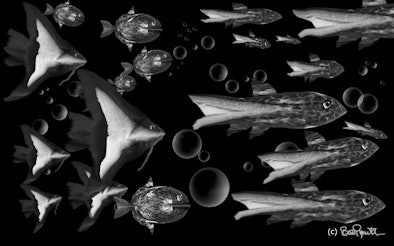 |
"When reading [the images], each particular view of one breast is placed alongside the same view of the opposite breast, producing sort of a mirror image," he said. "If one uses a little imagination, the two side-by-side mammographic images can be made to look like a sea dweller ... I added a few bubbles, and you have a busy underwater scene."
The scans come from three hospitals that all use the same PACS network, allowing access to a large pool of material, he said. "Mostly I use 'body parts,' but I'll also use background images from CT or MRI scans for certain inanimate objects."
He primarily uses CT and MRI in creating the works, but said he has also incorporated plain-film x-ray, ultrasound, and nuclear medicine scans, in addition to mammography. However, "CT is the modality I like to use the most," he said, "because it seems to provide the most interesting and versatile images."
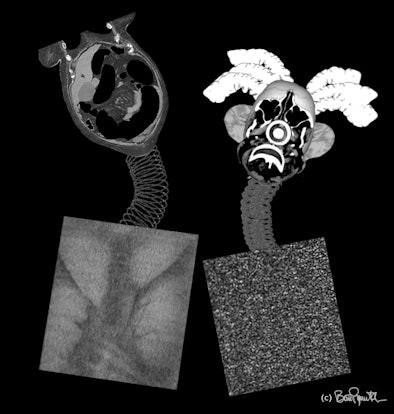 |
After identifying images of interest, Prywitch transfers them from the PACS and modifies them using the GNU Image Manipulation Program (GIMP), an open-source graphics application. He pulls out portions of the images, using GIMP to duplicate, sharpen/blur, or resize the selections, change the color or tone, or otherwise alter them.
Selecting the parts of images to be used can be a tedious process, he noted, and other challenges include maintaining the clarity of the image as it moves from PACS to the "canvas," and trying to create the desired balance of shades of gray.
"Making the images requires several layers, similar to if you stacked several transparencies on top of one another to make a final picture, with only a small part of the picture on each transparency," he said. "It's quite challenging to stack and arrange the layers just right to get what you want as your final product."
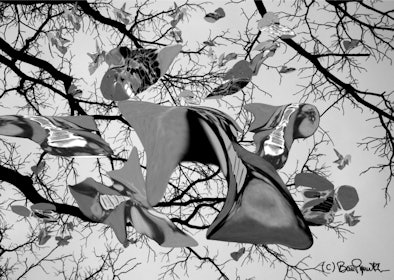 |
Before moving into digital art, Prywitch worked in pencil, oil, pastel, watercolor, and mixed media, he said. However, even before the transition, "I favored watercolors using just black ink, so they would be black, white, and shades of gray."
While not averse to using color, Prywitch said he generally prefers to work in black and white, with its ability to show the beauty and "starkness" that objects sometimes reflect.
This working in black and white -- or, more specifically, working with the shadows between them -- led Prywitch to name his collection and style of art "Penumbra." Also a radiation physics terms, penumbra refers to partial illumination or shadows, according to Prywitch, reflecting his focus on the shaded portions within radiology images.
Prywitch's artwork has been featured in RadioGraphics. To view the Penumbra website, click here.
By Nicole Pettit
AuntMinnie.com staff editor
January 13, 2011
Related Reading
Optical imaging deciphers truth within oil painting layers, May 26, 2010
Radiology art reveals beauty -- even in a Big Mac, February 26, 2009
Radiologist at Louvre trades healthcare for high art, November 1, 2002
Radiography meets flower power in RT's art, July 17, 2001
Copyright © 2011 AuntMinnie.com




